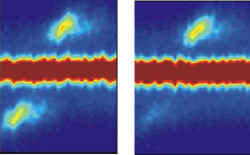Matter and Light Swap Roles

In the past few years, atomic physicists have gotten very good at handling matter in wave-like quantum states, with dramatic demonstrations like the atom laser. Another new display of wave phenomena is an exact reversal of the roles of particles and waves from classical physics: Waves of matter can diffract from “crystals” made of light. In the July Physical Review A, a team from the University of Innsbruck in Austria shows that some of the most subtle effects of ordinary x-ray diffraction can be reproduced by matter waves. They discovered an ingenious analogue for the absorption of waves by a crystal which they used to produce diffraction effects that were cleaner and easier to manipulate than those of real crystals.
The new paper describes a series of experiments on Bragg diffraction performed in the laboratory of Anton Zeilinger and Jörg Schmiedmayer over the past few years. Though many of the results have been reported before, it is “a useful compilation of a lot of different matter wave effects in one place,” says William Phillips of the National Institute of Standards and Technology in Gaithersburg, MD. “We’ve given a complete overview of how x-ray physics maps to matter diffraction,” Schmiedmayer says.
Zeilinger and Schmiedmayer’s “crystal” is actually a red laser beam, passed through a lens to expand it and then bounced off a mirror to create a standing wave. A uniform beam of argon atoms is their source of matter waves. The atoms pass almost perpendicularly through the laser beam, and they scatter off the “planes” of the standing wave at an angle called the Bragg angle. (For a thin grating there are several Bragg angles, but for a thick crystal, like the ones the Innsbruck team studied, the first one dominates.)
To complete the parallel between x-ray diffraction and matter-wave diffraction, Schmiedmayer and Zeilinger needed an analogue for absorption. “Basically every material has an absorption of x rays ,” Zeilinger says. But, of course, a photon of red light can scarcely absorb an argon atom. Instead, the team tuned the laser to excite atoms to states that were invisible to the detector. As far as the detector could tell, such excited atoms had simply been absorbed by the laser beam “crystal.”
In this way, the researchers were able to produce more sensitive versions of effects that had been seen in x-ray diffraction. “We have much more control over the potential,” says Schmiedmayer. “For x-ray diffraction you have to grow a new crystal, but here you just have to change the intensity of one beam or the other.”
One such effect is a “maximal” version of symmetry breaking. For real crystals with no absorption, x rays are scattered equally at the Bragg and negative Bragg angles, but for absorptive crystals there is an asymmetry. The team recreated this phenomenon by superimposing an “absorbing” and a “non-absorbing” light crystal and precisely controlling the positions of their crystal “planes” relative to one another. Because of their complete control over the light crystals, the team could concoct the most extreme version of the effect, and completely suppressed one of the Bragg peaks, which is not possible in real crystals.
Most researchers on atomic optics attempt to avoid absorption, says Phillips, but the Austrian team has “made a virtue out of a vice.” Zeilinger speculates that the ability to control the absorption of atoms in a matter wave might be useful in the future for atomic lithography.
–Dana Mackenzie
Dana Mackenzie is a freelance science writer.


